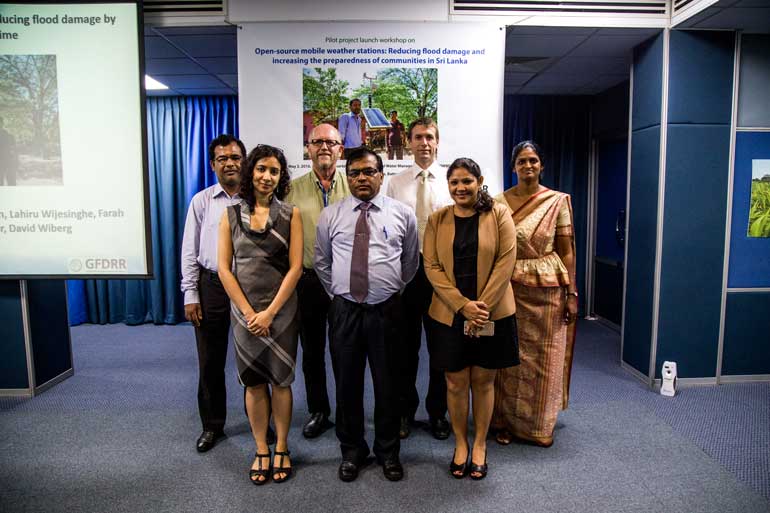Wednesday Feb 12, 2025
Wednesday Feb 12, 2025
Saturday, 7 May 2016 00:00 - - {{hitsCtrl.values.hits}}



A new, inexpensive portable weather station that can automatically measure and transmit rainfall, temperature and wind speed could transform Sri Lanka’s flood warning systems. Officially launched recently, the first of the new IWMI-designed devices is already being field tested near Anuradhapura.
Locally assembled using off-the-shelf technology and open source software – the weather stations log data every five minutes onto micro SD cards – just like the ones inside many mobile phones. The information can either be accessed directly from the card or be sent out as a SMS text message. Easy reprogramming of the software and possible inclusion of additional sensors make the gauges incredibly flexible for a variety of applications. The devices were originally conceived and assembled by Yann Chemin, a French scientist currently working with IWMI as a consultant.
“Sri Lankans are becoming increasingly affected by flooding,” said Secretary of the Ministry of Irrigation and Water Resources Management Wimalananda Ratnayake, speaking at a workshop to launch the project held at IWMI HQ in Pelawatte. “An early warning system is badly needed.”
Praising IWMI’s role in coordinating the initiative, he pointed out that the project will also help the Irrigation Department store water for irrigation more efficiently by enabling them to predict more accurately when tanks can be drained, ready to receive impending rainwater.
The Irrigation Department has requested that the first stations be installed near Malwathu Oya, in the catchment area of the Nachchaduwa Tank, which experiences regular monsoonal flooding. In the event of excessive rainfall (above 10 mm per hour), warnings can be sent out within minutes – a process that used to take up to 24 hours. Immediate action can be taken to adjust water levels in the tank in preparation. This can help not only mitigate flood risk, but also improve water storage management for other purposes.
At the workshop, representatives from the Irrigation Department, the Coordinating Secretariat for Science, Technology and Innovation (COSTI), Lanka Rain Water Harvesting Forum (LRWHF), and the University of Moratuwa also made presentations to share their experiences with weather stations in different applications around SriLanka.
“Management and planning requires measurement and monitoring, but networks are poor and degrading in many areas where they are most needed,” said IWMI’s David Wiberg, one of the scientists working on the research project. “Because of their low-cost, simplicity and flexibility, open-source mobile weather stations like these can enable management agencies with tight budgets to quickly develop or expand their monitoring networks. This will enhance resource security and productivity, contribute to development goals, and improve resilience to climate change and extreme events.”
The weather stations can last up to 10 years and cost only $ 350 (Rs. 50,000) each. Given their potential to reduce damage from flooding, it is estimated that they will pay for themselves in only 2½ years.
“This pilot project allows IWMI and the Irrigation Department to better understand operations and maintenance requirements and costs,” says Wiberg. “A great advantage of open-source stations is that parts can be developed and sourced locally so the management agency has full control over development, deployment and maintenance of its monitoring network.” The launch event will introduce the concept to a broad range of stakeholders and water professionals, with a long term objective of rolling out the program island-wide.

There is also interest in the concept further afield, with Pakistan and Canada among several countries developing similar interventions based on IWMI’s initial design.
The project, ‘Open source mobile weather stations: Reducing flood damage and increasing the preparedness of communities in Sri Lanka’, is funded by the Global Facility of Disaster Risk Reduction (GFDRR) of the World Bank, through its Challenge Fund. The research behind the weather station project is supported by the CGIAR Research Programs on Water Land and Ecosystems (WLE) and Climate Change, Agriculture and Food Security (CCAFS).
In addition to Wiberg and Chemin, the IWMI project team includes Soumya Balasubramanya, Farah Ahmed, Mohamed Aheeyar, Lahiru Wijesinghe and Richard Hardy.
The International Water Management Institute (IWMI) is a non-profit, scientific research organisation, headquartered in Colombo, which focuses on the sustainable use of water and land resources in developing countries. IWMI is a member of the CGIAR Consortium. CGIAR is a global partnership that unites organisations engaged in research for a food-secure future. It leads the CGIAR Research Program on Water, Land and Ecosystems which examines how we can intensify agriculture while still protecting the environment and lifting millions of farm families out of poverty.
– pix by Shaoyu Liu/IWMI
Discover Kapruka, the leading online shopping platform in Sri Lanka, where you can conveniently send Gifts and Flowers to your loved ones for any event including Valentine ’s Day. Explore a wide range of popular Shopping Categories on Kapruka, including Toys, Groceries, Electronics, Birthday Cakes, Fruits, Chocolates, Flower Bouquets, Clothing, Watches, Lingerie, Gift Sets and Jewellery. Also if you’re interested in selling with Kapruka, Partner Central by Kapruka is the best solution to start with. Moreover, through Kapruka Global Shop, you can also enjoy the convenience of purchasing products from renowned platforms like Amazon and eBay and have them delivered to Sri Lanka.
Discover Kapruka, the leading online shopping platform in Sri Lanka, where you can conveniently send Gifts and Flowers to your loved ones for any event including Valentine ’s Day. Explore a wide range of popular Shopping Categories on Kapruka, including Toys, Groceries, Electronics, Birthday Cakes, Fruits, Chocolates, Flower Bouquets, Clothing, Watches, Lingerie, Gift Sets and Jewellery. Also if you’re interested in selling with Kapruka, Partner Central by Kapruka is the best solution to start with. Moreover, through Kapruka Global Shop, you can also enjoy the convenience of purchasing products from renowned platforms like Amazon and eBay and have them delivered to Sri Lanka.